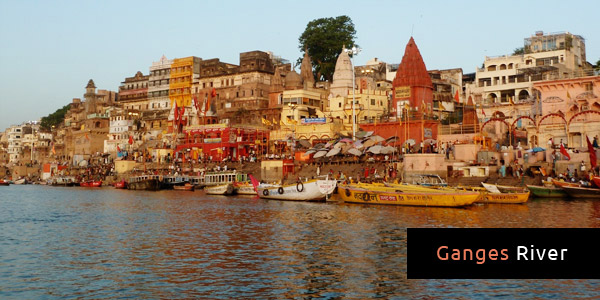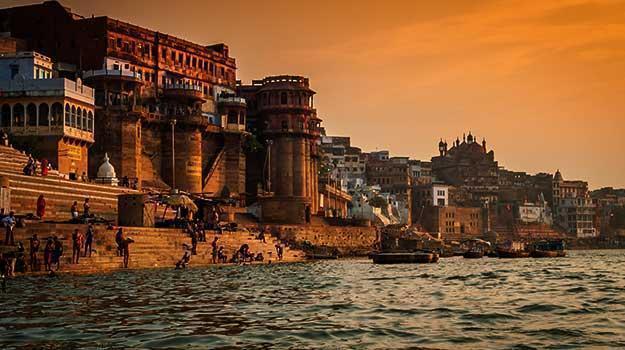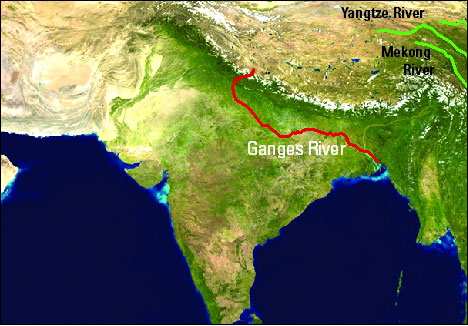The Ganges River
The Ganges also called the Ganga ,is the second largest river on the Indian subcontinent by discharge. Ganges river is named after a Hindu goddess called Ganga. Geographists to Historians and Mythologists regard Ganges as the heart of Indian culture, tradition and living.The Ganges, also Ganga is a trans-boundary river of Asia which flows through the nations of India and Bangladesh.
The Ganges is the biggest river in the Indian subcontinent in terms of water flow. The length of the Ganga is 2,510 km or 1,560 miles. The river has its origin in the Western Himalayan Ranges in the state of Uttarakhand. The followers of Hindu religion regard the Ganges to be the most sacred of all the rivers in India. The river is revered as the deity Ganga in Hindu religion. The river also has significant historical values - a number of colonial or royal capitals like Kannauj, Patliputra (modern day Patna), Allahabad, Kara, Baharampur, Murshidabad, and Kolkata are situated on the riverbanks of the Ganges.
The Ganges River Catchment Basin covers an area of 390,000 sq miles (1,000,000 sq km) and supplies to one of the maximum populated areas in the world. The average depth of the Ganges River is 16 m or 52 feet and the highest depth is 30 m or 100 feet. The river has been proclaimed as the National river of India. The first Prime Minister of India, Pandit Jawaharlal Nehru, cited a number of emblematic interpretations regarding the Ganges on the Indian subcontinent in his famous book, the Discovery of India (published in 1946).
The Ganges passes through the states of Uttarakhand, Uttar Pradesh, Bihar, Jharkhand, and West Bengal.
According to Hindus
- According to Hindu religion a very famous king Bhagiratha did tapasya for many years constantly to bring the river Ganges, then residing in the Heavens, down on the Earth to find salvation for his ancestors, who were cursed by a seer. Therefore, Ganges descended to the Earth through the lock of hair (Jata) of god Shiva to make whole earth pious, fertile and wash out the sins of humans. For Hindus in India, the Ganges is not just a river but a mother, a goddess, a tradition, a culture and much more.
- Ganga River is also said to be the river of supreme Lord Rama and also called "Ram Ganga" as there is a belief Lord Rama promised while Ganges emerged from his feet that, when He will appear on earth as Lord Rama will reside on the banks of Ganga and her tributaries. Lord Ram then appeared in Ayodhya which is on the banks of Saryu Ganga River, when he went to Janakpuri he crossed River Ganga in Haridwar. During his 14 years exile from Sita, his wife and brother Lakshmanaafter leaving Ayodhya his first night stay was at Tamsa River (Ganga tributaries), his second stay was at Shrungverpur which is on the banks of Ganga and with the help of Nishadraj Gruh and Kevat he crossed Ganga, he then went to Triveni sangam, Prayag Raj stayed with Muni Bharadvaj and then marched towards Chitrakoot and stayed there for 11 and half years on Kamadgiri parvat on the banks of Mandakini, holy stream. From there he went to Panchvati and stayed on the bank of Godavari until his wife sitaji was abducted by demon king Ravana. The search for his beloved wife Sita, Lord Rama went to Rameshwaram, as it is said all rivers meet the ocean.
- Some Hindus also believe life is incomplete without taking a bath in Ganges at least once in their lives. Many Hindu families keep a vial of water from the Ganges in their house. This is done because it is prestigious to have water of the Holy Ganges in the house, and also so that if someone is dying, that person will be able to drink its water. Hindus also believe that the water from the Ganges cleanses a person`s soul of all past sins, and that it can also cure the ill.
Interesting Facts about The Ganges River
- River Ganga is about 1557 miles long(2506 km).
- The Ganges basin is about 200 to 400 miles (322 to 644 km) wide.
- River Ganga originates from the Gangotri Glacier, on the southern slopes of the Himalayas, which is 14,000 feet above sea level.
- Rivers Bhagirathi and Alaknanda join each other at Devprayag to form River Ganga.
- Hindus have always believed Ganga Jal to be pure, pious and drinkable.
- In many Hindu rituals (from birth to death) much reverence is given to Ganga water.
- River Ganga is considered to be very pure.
- In 1896, a British bacteriologist Ernest Hanbury Hankin tested the bacterium Vibrio Cholerae that causes the deadly disease cholera, and found that this bacterium died within three hours when put into the waters of Ganga.
- The same bacteria continued to thrive in distilled water even after 48 hours.
- The presence of bacteriophages (viruses that kill bacteria) in the water of the Ganges is considered as the reason behind this quality and its purity.
- In a study conducted by Malaria Research Center in New Delhi it was observed that water from the upper ambits of Ganga did not host mosquito breeding, and also prevented mosquito breeding if added to other water sources.
- An unknown substance in Ganga acts on organic materials and bacteria and kills them.
- The Ganga’s self-purifying quality leads to oxygen levels 25 times higher than any other river in the world.
- Mistpouffers or Barisal Guns are unexplained sounds that resemble a sonic boom that have been reported to be heard in Ganga. They resemble the sonic boom of a supersonic jet.
- The Ganga in Haridwar has shifted from its original course by 500 meters in the past few decades. In Bihar, some parts of the river have shifted more than 2.5 km since 1990.
- River Ganga holds a sacred place in the hearts of Indians.




No comments:
Post a Comment